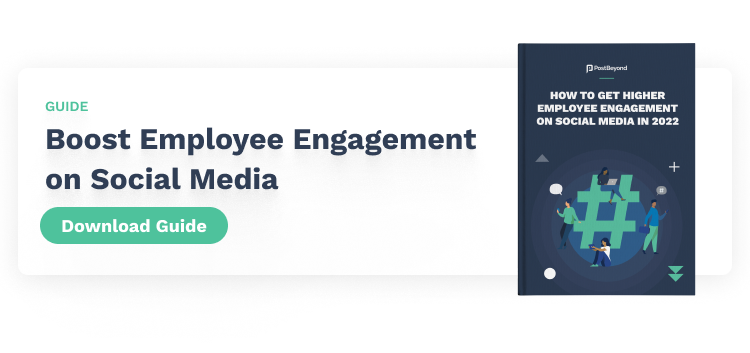Marketers are up against more competition than ever. In fact, not only are we fighting against more companies for attention, but audiences are way more selective. It’s no surprise then that we’re all looking at video marketing strategies to breakthrough the noise.
And here’s why video marketing now matters more than ever:
- 94% of marketers said that video converted as well – or better – than other types of content. (Vidyard).
- 86% of audiences said they would prefer seeing more videos from brands (Wyzowl).
- Millennials spend 2.4 hours a day watching videos, while Gen Z watch videos for around 3.4 hours a day (HubSpot).
However, with brands increasing video production by 135% year-over-year, we know that just posting a video isn’t going to cut it. We want to know what actually works, especially when we are just starting our video marketing efforts.
We found 9 video marketing examples that are both effective and doable without the need for a high-powered production team. If you’re looking to build thought leadership or drive your social selling and/or social recruiting efforts, then try these out!
9 Video Marketing Examples You Can Try Today
1. Moz – Repurpose Your Blog Content
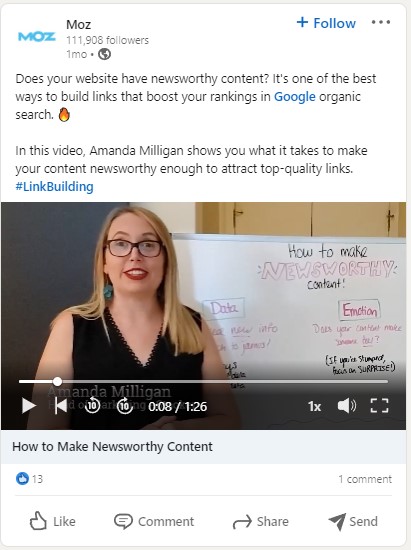
The Moz Blog has always been a go-to resource for budding SEO experts. Now Moz is taking the information on its blogs to video. The videos are short, digestible and to the point. Not only that, but they’re episodic and Moz posts a new lesson every month.
Why This Works
This is a great strategy for rapidly ideating video content. Your company blog is a potential gold mine of valuable insights, research, data and so much more. If you’re building a video marketing strategy, then your first step should be to catalog and tag blog content for video.
Here’s How to Do It
Moz shows us we don’t need to get too fancy. Find an employee who can serve as the thought leader or subject matter expert (SME) on the topic. Get them to lead the video or even interview them – either way, put a relatable person at the center.
This is a good strategy for encouraging your employees to share the video. It’s about them just as much (if not more) as the brand. When your employees share content, it gives your content more legs in terms of reach and engagement. People trust information from their peers – such as colleagues – more than official brand posts.
2. Stonly – Connect With Others
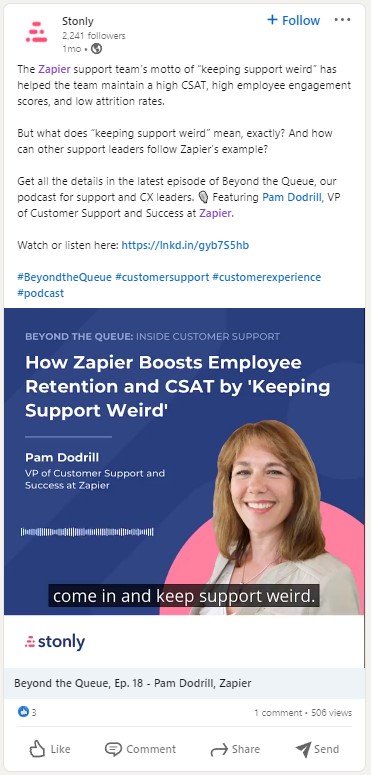
In this example Stonly is interviewing Zapier’s VP of Customer Support and Success, Pam Dodrill. This video marketing strategy does two things. First, it positions Stonly as a credible thought leader. Second, it draws in Zapier to help promote Stonly.
Why This Works
The key here is to build credibility and to get others to help promote your video content. This helps you get in front of new audiences while also giving people a reason to engage or follow your official brand page.
Here’s How to Do It
Reach out to your company’s partners and/or customers to see if they’d be interested in an interview, webinar or podcast. Work out a strategy that involves their marketing team so that once the content is out, they share it with their networks.
3. Bizzabo – Show Job Candidates What to Expect
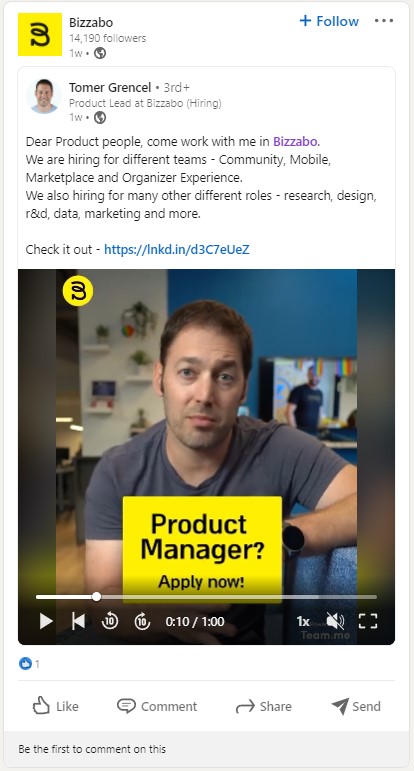
Bizzabo’s post is a great case of “showing” instead of only “telling”. The company used video to attract strong job applicants. However, it featured the hiring manager who, in turn, outlined what prospects can expect from the process and the company.
Why This Works
The video gives prospects a deeper look at the company as well as its culture and staff. If you’re trying to attract people who would fit well with your team, showing them what to expect early on is a great strategy. It also stands out compared to static text-only job postings.
Here’s How to Do It
Try getting the hiring manager in front of the camera to talk about the role(s), the team, and the hiring process.
4. Wistia – Celebrate Customers and Partners
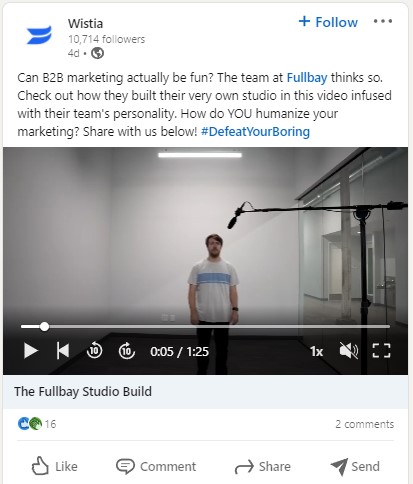
Wistia is using video to spotlight another company’s growth. This is a great way to leverage the success of your customers and partners.
Why This Works
It invites discussion by giving people something genuinely interesting to watch. It also shows your customers and partners that you’re deeply invested in their success. It could encourage their marketing as well as their own employees, customers and partners to promote the video.
Here’s How to Do It
Reach out to your customers and partners to see if they would be interested in letting you share or spotlight their success. Create a process that encourages them to engage with you ahead of time so that you can prepare a video asset.
5. Shopify – Show Thought Leadership
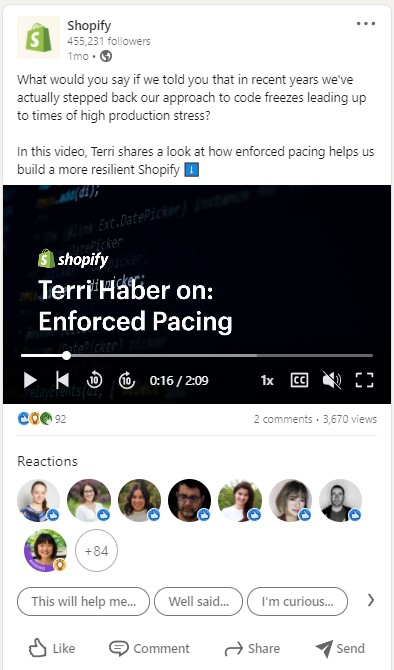
Shopify’s video marketing example is a deep example of thought leadership.
On the surface, it’s definitely a case of them spotlighting the expertise of a key employee. But it also subtly discusses an aspect of that company’s culture (e.g. to try new ideas, work differently than the norm, etc). It finally builds up to showing the benefits of using the Shopify platform.
Why This Works
Shopify’s style helps it both promote its core offering and its credibility. However, it accomplishes both by helping the viewer. In this case, Shopify is providing a valuable insight about an issue or strategy in the minds of engineering leaders. Shopify provides the audience a tangible reason to view the video (e.g. an answer to an important question).
Here’s How to Do It
Talk to your engineering, customer success and other critical teams. They’re sitting on valuable insights that you can deliver through interviews, webinars and shorts.
6. Gong – Spotlight Partner Expertise
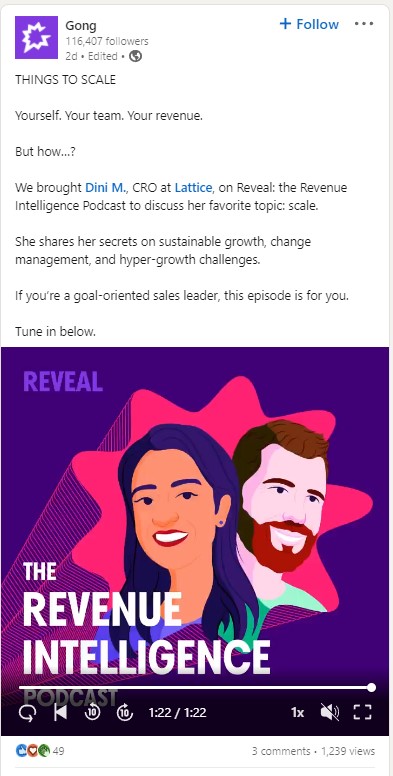
Gong offers another example of leveraging your customers and partners for video marketing. In this case, Gong is drawing on an SME from another company.
Why This Works
Sure, this strategy puts the thought leadership of your customer or partner at the center. But it still gives your brand a way to reach new audiences. Those following your partner company will want to know what they think, but they’ll get those insights through your brand.
Here’s How to Do It
Reach out to customers, partners and even companies you’re simply interested in engaging for an interview or webinar.
7. Ahrefs – Provide Tutorials
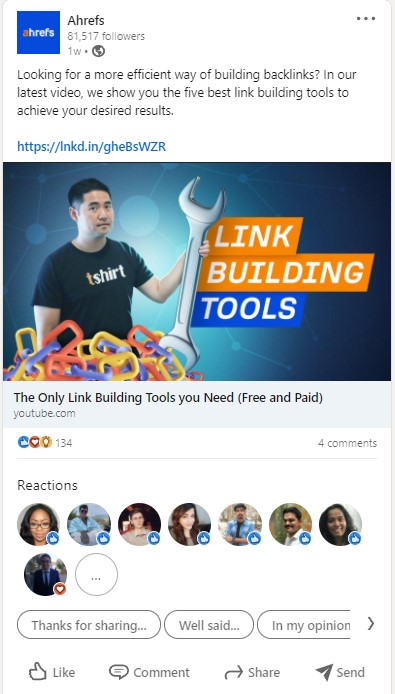
In this video, Ahrefs is giving budding SEO professionals helpful tips on how to carry out a key aspect of their jobs. Like Moz, the video echoes a lot of what Ahrefs has already written about on its blog. However, this takes a very tutorial or training-like approach. It’s rich in detail and it really makes the viewer feel like they came out of it with something valuable.
Why This Works
This video is a great example of how to execute longer form media. Granted, it may take a bit more production work than our earlier examples. This is a solid strategy for retaining long-term audience interest in your brand as it presents you as a helpful resource or hub.
Here’s How to Do It
The key is to give the reader something valuable. They need to know from the beginning that the video will result in a tangible benefit. This could be helpful knowledge for their work, new skill sets, tips for industry certifications or exams, or something else of value.
8. HubSpot – Show Social Proofs

HubSpot is using videos to showcase its case studies and other social proofs for bottom-funnel target audiences. With social selling becoming increasingly key, videos like this are a powerful asset for sales teams to use when engaging their networks.
Why This Works
Videos like this are strong social selling assets. They allow decision-makers to start evaluating your product or service in a convenient way. It also lets you showcase the main benefits of your offering in dynamic and memorable ways.
Here’s How to Do It
Look at your text-based case studies to see if you can repurpose some of them into videos. You can also talk to your customers to see if they can help you make a case study video.
Start with a simple video like a short interview with the customer. Let them talk about how they used your product or service to achieve a goal or resolve a major problem.
9. Dell Technologies – Promote Company Culture

Dell Technologies uses a lot of video in its talent acquisition efforts. Here, Dell is promoting how its company culture long adapted to remote and flexible work. It also spotlights an employee to showcase how the company wants its employees to maintain a work-life balance.
Why This Works
Videos like this give potential job candidates a window into how your company works and treats its employees. However, spotlighting the team is a great way to encourage employees to share the video and promote Dell to their networks.
Here’s How to Do It
Convince employees to buy into regularly providing testimonials and other commentary about their experience with the company. Besides using that material to create branded videos, you should also encourage employees to create their own content. Employee-generated content (EGC) offers another layer of authenticity, which helps build more trust with audiences.
Next Steps
These video marketing examples show us that we don’t need top-end production value to produce videos audiences want. Getting a start shouldn’t be a problem.
The real challenge is delivery. To succeed, you need to leverage each platform’s preferences (especially native video playback). You also need to involve your employees in spreading your content.


